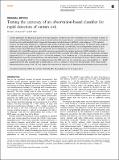Testing the accuracy of an observation-based classifier for rapid detection of autism risk

View/
Author
Duda, M
Kosmicki, J A
Wall, D P
Published Version
https://doi.org/10.1038/tp.2014.65Metadata
Show full item recordCitation
Duda, M, J A Kosmicki, and D P Wall. 2014. “Testing the accuracy of an observation-based classifier for rapid detection of autism risk.” Translational Psychiatry 4 (8): e424. doi:10.1038/tp.2014.65. http://dx.doi.org/10.1038/tp.2014.65.Abstract
Current approaches for diagnosing autism have high diagnostic validity but are time consuming and can contribute to delays in arriving at an official diagnosis. In a pilot study, we used machine learning to derive a classifier that represented a 72% reduction in length from the gold-standard Autism Diagnostic Observation Schedule-Generic (ADOS-G), while retaining >97% statistical accuracy. The pilot study focused on a relatively small sample of children with and without autism. The present study sought to further test the accuracy of the classifier (termed the observation-based classifier (OBC)) on an independent sample of 2616 children scored using ADOS from five data repositories and including both spectrum (n=2333) and non-spectrum (n=283) individuals. We tested OBC outcomes against the outcomes provided by the original and current ADOS algorithms, the best estimate clinical diagnosis, and the comparison score severity metric associated with ADOS-2. The OBC was significantly correlated with the ADOS-G (r=−0.814) and ADOS-2 (r=−0.779) and exhibited >97% sensitivity and >77% specificity in comparison to both ADOS algorithm scores. The correspondence to the best estimate clinical diagnosis was also high (accuracy=96.8%), with sensitivity of 97.1% and specificity of 83.3%. The correlation between the OBC score and the comparison score was significant (r=−0.628), suggesting that the OBC provides both a classification as well as a measure of severity of the phenotype. These results further demonstrate the accuracy of the OBC and suggest that reductions in the process of detecting and monitoring autism are possible.Other Sources
http://www.ncbi.nlm.nih.gov/pmc/articles/PMC4150240/pdf/Terms of Use
This article is made available under the terms and conditions applicable to Other Posted Material, as set forth at http://nrs.harvard.edu/urn-3:HUL.InstRepos:dash.current.terms-of-use#LAACitable link to this page
http://nrs.harvard.edu/urn-3:HUL.InstRepos:12987396
Collections
- HMS Scholarly Articles [17922]
Contact administrator regarding this item (to report mistakes or request changes)

